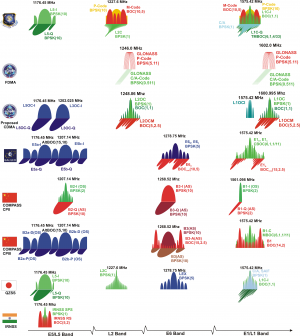If you wish to contribute or participate in the discussions about articles you are invited to contact the Editor
Galileo Open Service (OS): Difference between revisions
Gema.Cueto (talk | contribs) No edit summary |
Gema.Cueto (talk | contribs) No edit summary |
||
| Line 11: | Line 11: | ||
The Galileo Open Service (OS) enables free of charge, global ranging, positioning and timing, by means of the Galileo OS Signal-In-Space (SIS). | The Galileo Open Service (OS) enables free of charge, global ranging, positioning and timing, by means of the Galileo OS Signal-In-Space (SIS). | ||
The freely accessible Galileo Open Service (OS) targets the mass market and it is intended for motor vehicle navigation and location-based mobile telephone services. Free to the user, it provides positioning and synchronization information intended for high-volume satellite radio navigation applications. | The freely accessible Galileo Open Service (OS) targets the mass market and it is intended for motor vehicle navigation and location-based mobile telephone services. Free to the user, it provides positioning and synchronization information intended for high-volume satellite radio navigation applications. | ||
==Purpose== | ==Purpose== | ||
| Line 39: | Line 39: | ||
{| class="wikitable" align="center" | {| class="wikitable" align="center" | ||
|+align="bottom" |''Service Performances for Galileo Open Service'' | |+align="bottom" |''Service Performances for Galileo Open Service (requirements)'' | ||
|- | |- | ||
! rowspan="2" | | ! rowspan="2" | | ||
! colspan="2"| Galileo Open Service (positioning & timing) | ! colspan="2"| Galileo Open Service (positioning & timing (requirements)) | ||
|- align="center" | |- align="center" | ||
! Single Frequency (SF) | ! Single Frequency (SF) | ||
| Line 80: | Line 80: | ||
[[File:EvolutionGalOSAv.png]] | [[File:EvolutionGalOSAv.png]] | ||
==Galileo Signal Frequencies== | |||
Following image shows the Galileo Signal Frequencies <ref>[https://galileognss.eu/galileo-frequency-bands/]</ref> | |||
[[File:Galileo Signals in Space.png|300px|Galileo Signal Frequencies|centre]] | |||
==Credits== | ==Credits== | ||
Revision as of 14:31, 28 November 2018
| GALILEO | |
|---|---|
| Title | Galileo Open Service (OS) |
| Edited by | GMV |
| Level | Basic |
| Year of Publication | 2011 |
Galileo is the European Global Navigation Satellite System, under civil control, that provides satellite positioning services to European citizens and worldwide.
The Galileo Open Service (OS) enables free of charge, global ranging, positioning and timing, by means of the Galileo OS Signal-In-Space (SIS).
The freely accessible Galileo Open Service (OS) targets the mass market and it is intended for motor vehicle navigation and location-based mobile telephone services. Free to the user, it provides positioning and synchronization information intended for high-volume satellite radio navigation applications.
Purpose
The Galileo Open Service (OS) provides positioning, velocity and timing information that can be accessed free of direct user charge. This service is suitable for mass-market applications, such as in-car navigation and hybridisation with mobile telephones. The Open Service is accessible to any user equipped with a receiver, with no authorisation required. While up to three separate signal frequencies are offered within the Open Service, cheap single-frequency receivers will be used for applications requiring only reduced accuracy. In general, Open Service applications will use a combination of Galileo and GPS signals, which will improve performance in severe environments such as urban areas[1]. The Open Service could also be used by professionals who require high precision but not integrity, complementing this service with GNSS Augmentation techniques.
The timing service is synchronised with UTC when used with receivers in fixed locations. This timing service can be used for applications such as network synchronisation or scientific applications.[2]
The Open Service does not offer integrity information, and the determination of the quality of the signals will be left entirely to the users. There will be no service guarantee or liability from the Galileo Operating Company on the Open Service.[3]
The following services are supported by Galileo OS SIS:
- Single-Frequency and Dual-Frequency Ranging
- Single-Frequency and Dual-Frequency Positioning
- UTC Time Determination
During the Galileo Initial Services phase, the Galileo OS comprises the Ranging and the UTC Time Determination Services:
- Gal OS Single-Frequency and Dual-Frequency Ranging Service: this service is provided in both SF usage mode and DF usage mode. DF usage mode is characterized by higher accuracy of the range measurement. The use of two frequencies allows better compensation of the disturbing effect of the ionosphere on the SIS, thus providing better performance to the end user. The Galileo OS Ranging Service is interoperable with GPS ranging services and therefore it provides a direct benefit to users who are able to exploit both Galileo and GPS constellations, by increasing the number of available SiS.
- Gal OS UTC Time Determination Service: this service provides Galileo users worldwide with direct and accurate access to the UTC reference. It provides both the integer offset between the Galileo System Time (GST) and UTC, and the fractional GSTUTC difference at nanosecond level. This allows users to time-stamp their data in UTC or local time and to precisely synchronise to UTC their clocks, which can be situated at very different locations in the world.
Performance and features
The Galileo Open Service is accessible through the signals at L1, E5a and E5b, whether data or pilot. Several combinations are also possible, such as a dual frequency service based on using L1 and E5a (for best ionospheric error cancellation) or single frequency services (at L1, E5a, E5b or E5a and E5b together) in which case the ionospheric error is removed using a model, and even triple frequency services using all the signals together (L1, E5a and E5b), which can be exploited for very precise, centimetric applications.[3] [4]
The performance objectives in terms of position accuracy and availability will be competitive with respect to existing GNSS and further planned evolutions. In addition, the Open Service will also be interoperable with other GNSS, in order to facilitate the provision of combined services. [2]
| Galileo Open Service (positioning & timing (requirements)) | ||
|---|---|---|
| Single Frequency (SF) | Dual Frequency (DF) | |
| Coverage | Global | |
| Accuracy (95%) | Horizontal: 15 m | Horizontal: 4m |
| Vertical: 35 m | Vertical: 8m | |
| Availability | 99.8 % | |
| Timing Accuracy wrt UTC/TAI | N/A | 30 ns |
| Ionospheric Correction | Based on SF Model | Based on DF Measurements |
| Integrity | No | |
Next table presents the expected evolution of the horizontal and vertical position accuracy for the Galileo OS Positioning versus the number of operational healthy satellites [5] . The values provided are global values, taking into account the constraint of PDOP ≤6.
With regard to the evolution of the availability performance, the next table summarize the expected figures for 9, 15 and 24 satellites.
Galileo Signal Frequencies
Following image shows the Galileo Signal Frequencies [6]
Credits
Edited by GMV, using information from ESA and European Union as indicated through the references.
References
- ^ Galileo Services at ESA Galileo web page
- ^ a b Galileo Mission High Level Definition, v3, September 2002.
- ^ a b ESA Galileo web page
- ^ Galileo OS SIS ICD Issue 1 Revision 2 November 2015
- ^ Galileo SDD
- ^ [1]




